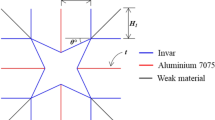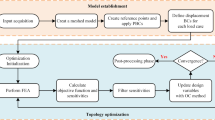Abstract
Thermal elastic metamaterials with extreme positive or negative thermal expansion properties have great potential applications in designing and manufacturing thermal actuators. In this paper, a concurrent topology optimization method is proposed for metamaterial thermal actuator design. The actuator is composed of multiple metamaterials with different microstructures. The microstructures are composed of two common materials, aluminum and invar. The concurrent optimization method is capable of simultaneously designing the topology, the arrangement of the multiple metamaterials, and the microstructures of the metamaterials. The macro-topology and the multiple metamaterial microstructures are optimized simultaneously through density-based topology optimization method and multi-phase material optimization method. A sensitivity clustering-based method is proposed and used to partition the macrostructure into several sub-domains, each of which is occupied with appropriate individual metamaterial. The sensitivity of the optimization objective with respect to the thermal expansion coefficients is chosen as the criterion to generate data points for clustering, and the fuzzy c-means (FCM) method is adopted for data clustering. The grouped microstructures will greatly reduce the computational burden and at the same time improve the manufacturability and structural performance. Several numerical examples are presented, including the design with single output point and multiple output points. Optimization results show that both the macro-topology and the metamaterial microstructures are significantly affected by the actuation impedance adopted in the optimization. The effect of number of clusters on the optimization results is studied.






















Similar content being viewed by others
References
Abdullah EJ, Soriano J, Garrido IF, Majid DLA (2020) Accurate position control of shape memory alloy actuation using displacement feedback and self-sensing system. Microsyst Technol 27:2553–2566
Alacoque L, Watkins RT, Tamijani AY (2021) Stress-based and robust topology optimization for thermoelastic multi-material periodic microstructures. Comput Methods Appl Mech Eng 379:113749
Ansola DR, Vegueria ME, Canales PJ (2010) An element addition strategy for thermally actuated compliant mechanisms topology optimization. Eng Comput 27:694–711
Bendsoe MP, Sigmund O (1999) Material interpolation schemes in topology optimization. Arch Appl Mech 69:635–654
Bezdek JC (1981) Pattern recognition with fuzzy objective function algorithms, 1st edn. Springer, New York
Bourdin B (2001) Filters in topology optimization. Int J Numer Methods Eng 50:2143–2158
Bruns TE, Tortorelli DA (2001) Topology optimization of non-linear elastic structures and compliant mechanisms. Comput Methods Appl Mech Eng 190:3443–3459
Devries F, Dumontet H, Duvaut G, Lene F (1989) Homogenization and damage for composite structures. Int J Numer Methods Eng 27:285–290
Du Y, Luo Z, Tian Q, Chen L (2009) Topology optimization for thermo-mechanical compliant actuators using mesh-free methods. Eng Optim 41:753–772
Dzung NT, Nam DP, Dich NQ (2019) Modelling and control design of a V-shaped thermal actuator system via partial derivative equation approach. In: Proceedings of 2019 5th international conference on mechatronics and robotics engineering (ICMRE 2019), pp 78–82
Guedes JM, Kikuchi N (1990) Preprocessing and postprocessing for materials based on the homogenization method with adaptive finite-element methods. Comput Methods Appl Mech Eng 83:143–198
Guest JK, Prevost JH, Belytschko T (2004) Achieving minimum length scale in topology optimization using nodal design variables and projection functions. Int J Numer Methods Eng 61:238–254
Hartigan JA, Wong MA (1979) A K-means clustering algorithm. Appl Stat 28:100–108
Huang X, Radman A, Xie YM (2011) Topological design of microstructures of cellular materials for maximum bulk or shear modulus. Comput Mater Sci 50:1861–1870
Jonsmann J, Sigmund O, Bouwstra S (1999) Compliant thermal microactuators. Sensors Actuators A 76(1–3):463–469
Kumar T, Suresh K (2020) A density-and-strain-based K-clustering approach to microstructural topology optimization. Struct Multidisc Optim 61:1399–1415
Li Q, Xu R, Wu Q, Liu S (2021a) Topology optimization design of quasi-periodic cellular structures based on erode–dilate operators. Comput Methods Appl Mech Eng 377:113720
Li Q, Sigmund O, Jensen JS, Aage N (2021b) Reduced-order methods for dynamic problems in topology optimization: a comparative study. Comput Methods Appl Mech Eng 387:114149
Li Q, Xu R, Liu S, Liang G, Qu Y (2022) Topology optimization design of multi-material quasi-periodic cellular structures for thermoelastic responses. Int J Numer Methods Eng 123:4345–4366
Liu L, Yan J, Cheng GD (2008) Optimum structure with homogeneous optimum truss-like material. Comput Struct 86:1417–1425
Liu K, Tovar A, Nutwell E, Detwiler D (2016) Towards nonlinear multimaterial topology optimization using unsupervised machine learning and metamodel-based optimization. In: International design engineering technical conferences and computers and information in engineering conference, 2015, vol 2b
Lloyd S (1982) Least squares quantization in PCM. IEEE Trans Inf Theory 28:129–137
Luo Z, Tong L, Ma H (2009) Shape and topology optimization for electrothermomechanical microactuators using level set methods. J Comput Phys 228:3173–3181
MacQueen J (1967) Some methods for classification and analysis of multivariate observations. In: Proceedings of the fifth Berkeley symposium on mathematical statistics and probability, vol 1, no 14, pp 281–297
Mankame ND, Ananthasuresh GK (2004) Topology synthesis of electrothermal compliant mechanisms using line elements. Struct Multidisc Optim 26:209–218
Nie Y, Li Z, Cheng G (2021) Efficient prediction of the effective nonlinear properties of porous material by FEM-cluster based analysis (FCA). Comput Methods Appl Mech Eng 383:113921
Pedersen P (1989) On optimal orientation of orthotropic materials. Struct Multidisc Optim 1:101–106
Qiu Z, Li Q, Liu S, Xu R (2020) Clustering-based concurrent topology optimization with macrostructure, components, and materials. Struct Multidisc Optim 63:1243–1263
Querin OM, Steven GP, Xie YM (1998) Evolutionary structural optimisation (ESO) using a bidirectional algorithm. Eng Comput 15:1031–1048
Rodrigues H, Guedes JM, Bendsoe MP (2002) Hierarchical optimization of material and structure. Struct Multidisc Optim 24:1–10
Rozvany GIN, Zhou M, Birker T (1992) Generalized shape optimization without homogenization. Struct Optim 4:250–252
Ruspini EH (1969) A new approach to clustering. Inf Control 15:22–32
Sigmund O (1994) Materials with prescribed constitutive parameters—an inverse homogenization problem. Int J Solids Struct 31:2313–2329
Sigmund O (2000) Design of multiphysics actuators using topology optimization ± Part I: one-material structures. Comput Methods Appl Mech Eng 190:6577–6604
Sigmund O (2001) Design of multiphysics actuators using topology optimization ± Part II: two-material structures. Comput Methods Appl Mech Eng 190:6605–6627
Sigmund O, Torquato S (1997) Design of materials with extreme thermal expansion using a three-phase topology optimization method. J Mech Phys Solids 45:1037–1067
Svanberg K (1987) The method of moving asymptotes—a new method for structural optimization. Int J Numer Methods Eng 24:359–373
Takezawa A, Kobashi M (2017) Design methodology for porous composites with tunable thermal expansion produced by multi-material topology optimization and additive manufacturing. Compos B 131:21–29
Tian X, Chen W, Gao R, Liu S, Wang J (2020) Perforation-rotation based approach for band gap creation and enlargement in low porosity architected materials. Compos Struct 245:112331
Vogiatzis P, Chen SK, Wang X, Li TT, Wang LF (2017) Topology optimization of multi-material negative Poisson’s ratio metamaterials using a reconciled level set method. Comput Aided Des 83:15–32
Wang LW, Tao SY, Zhu P, Chen W (2021) Data-driven topology optimization with multiclass microstructures using latent variable Gaussian process. J Mech Design 143:031708
Watts S, Tortorelli DA (2017) Optimality of thermal expansion bounds in three dimensions. Extreme Mech Lett 12:97–100
Wei C, Zhang Z, Cheng D, Sun Z, Zhu M, Li L (2020) An overview of laser-based multiple metallic material additive manufacturing: from macro- to micro-scales. Int J Extreme Manuf 3:012003
Xia Q, Shi TL (2020) Multiphysics topology optimization of thermal actuators by using the level set-based multiple-type boundary method. Int J Comput Methods 17:1950044
Xia Q, Xia L, Shi TL (2018) Topology optimization of thermal actuator and its support using the level set based multiple-type boundary method and sensitivity analysis based on constrained variational principle. Struct Multidisc Optim 57:1317–1327
Xie YM, Steven GP (1993) A simple evolutionary procedure for structural optimization. Comput Struct 49:885–896
Xu L, Cheng GD (2018) Two-scale concurrent topology optimization with multiple micro materials based on principal stress orientation. Struct Multidisc Optim 57:2093–2107
Yan J, Guo X, Cheng GD (2016) Multi-scale concurrent material and structural design under mechanical and thermal loads. Comput Mech 57:437–446
Yan J, Sui QQ, Fan ZR, Duan ZY, Yu T (2020) Clustering-based multiscale topology optimization of thermo-elastic lattice structures. Comput Mech 66:979–1002
Yang Z, Zhang Y, Liu S, Wu Z (2021) Microstructural topology optimization for patch-based sandwich panel with desired in-plane thermal expansion and structural stiffness. Struct Multidisc Optim 64:779–795
Ye HL, Zhang X, Wei N (2021) Topology optimization design of adjustable thermal expansion metamaterial based on independent continuous variables. Int J Appl Mech 13:2150032
Zhao J, Yoon H, Youn BD (2018) An efficient decoupled sensitivity analysis method for multiscale concurrent topology optimization problems. Struct Multidisc Optim 58:445–457
Zhou S, Li Q (2008) Computational design of multi-phase microstructural materials for extremal conductivity. Comput Mater Sci 43:549–564
Zhou M, Rozvany GIN (1991) The Coc algorithm, part 2: topological, geometrical and generalized shape optimization. Comput Methods Appl Mech Eng 89:309–336
Zhu B, Zhang X (2012) A new level set method for topology optimization of distributed compliant mechanisms. Int J Numer Methods Eng 91:843–871
Acknowledgements
The authors gratefully acknowledge the financial support to this work by the National Natural Science Foundation of China (Grant Nos. 12272076, 11821202), the 111 Project (B14013), and the Fundamental Research Funds for the Central Universities of China (DUT21GF101). The authors are also grateful to the anonymous reviewers for their valuable suggestions and comments.
Funding
Funding was provided by the National Natural Science Foundation of China (12272076), Overseas Expertise Introduction Project for Discipline Innovation (B14013), and Fundamental Research Funds for the Central Universities (DUT21GF101).
Author information
Authors and Affiliations
Corresponding author
Ethics declarations
Conflict of interest
On behalf of all authors, the corresponding author states that there is no conflict of interest.
Replication of results
The MATLAB codes used to generate results are available upon request.
Additional information
Responsible Editor: Seonho Cho
Publisher's Note
Springer Nature remains neutral with regard to jurisdictional claims in published maps and institutional affiliations.
Rights and permissions
Springer Nature or its licensor (e.g. a society or other partner) holds exclusive rights to this article under a publishing agreement with the author(s) or other rightsholder(s); author self-archiving of the accepted manuscript version of this article is solely governed by the terms of such publishing agreement and applicable law.
About this article
Cite this article
Qiu, Z., Li, Q. & Liu, S. Sensitivity clustering-based multi-scale topology optimization method for metamaterial thermal actuators. Struct Multidisc Optim 67, 9 (2024). https://doi.org/10.1007/s00158-023-03729-z
Received:
Revised:
Accepted:
Published:
DOI: https://doi.org/10.1007/s00158-023-03729-z




